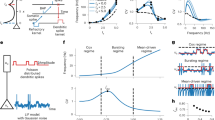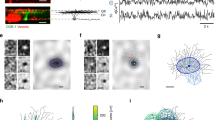Abstract
We explore the influence of synaptic location and form on the behavior of networks of coupled cortical oscillators. First, we develop a model of two coupled somatic oscillators that includes passive dendritic cables. Using a phase model approach, we show that the synchronous solution can change from a stable solution to an unstable one as the cable lengthens and the synaptic position moves further from the soma. We confirm this prediction using a system of coupled compartmental models. We also demonstrate that when the synchronous solution becomes unstable, a bifurcation occurs and a pair of asynchronous stable solutions appear, causing a phase lag between the cells in the system. Then using a variety of coupling functions and different synaptic positions, we show that distal connections and broad synaptic time courses encourage phase lags that can be reduced, eliminated, or enhanced by the presence of active currents in the dendrite. This mechanism may appear in neural systems where proximal connections could be used to encourage synchrony, and distal connections and broad synaptic time courses could be used to produce phase lags that can be modulated by active currents.
Similar content being viewed by others
References
Bower JM (1995) Reverse engineering the nervous system: An in vivo, in vitro, and in computo approach to understanding the mammalian olfactory system. In: S Zornetzer, J Davis, C Lau, eds. An Introduction to Neural and Electronic Networks. Academic Press, New York. pp. 3–28.
Bressler SL (1984) Spatial organization of EEGs from olfactory bulb and cortex. Electroencephal. Clinical Neurophysiol. 57:270–276.
Bressloff PC (1995) Integro-differential equations and the stability of neural networks with dendritic structure. Biol. Cybernetics 73:281–290.
Cohen A, Ermentrout GB, Kiemel T, Kopell N, Sigvardt KA, Williams TL (1992) Modeling of intersegmental coordination in the lamprey central pattern generator for locomotion. Trends in Neurosci. 15:434–438.
Coombes S, Lord GJ (1997) Intrinsic modulation of pulse-coupled integrate-and-fire neurons. Physical Rev. E (in press).
Crook SM, Ermentrout GB, Vanier MC, Bower JM (1997) The role of axonal delay in the synchronization of networks of coupled cortical oscillators. J. Comput. Neurosci. 4:161–172.
Eeckman FH, Freeman WJ (1990) Correlations between unit firing and EEG in the rat olfactory system. Brain Res. 528:238–244.
Ermentrout GB (1996). Type I membranes, phase resetting curves, and synchrony. Neural Comput. 8:979–1001.
Ermentrout GB, Kopell N (1984) Frequency plateaus in a chain of weakly coupled oscillators. SIAM J. Math. Anal. 15:215–237.
Ermentrout GB, Kopell N (1990) Oscillator death in systems of coupled neural oscillators. SIAM J. App. Math. 50:125–146.
Ermentrout GB, Kopell N (1991) Multiple pulse interactions and averaging in systems of coupled neural oscillators. J. Math. Biol. 29:195–217.
Freeman WJ (1978) Spatial properties of an EEG event in the olfactory bulb and cortex. Electroencephal. Clin. Neurophysiol. 44:586–605.
Golomb D, Wang X-J, Rinzel J (1996) Propagation of spindle waves in a thalamic slice model. J. Neurophysiol. 75:750–769.
Gray CM (1994) Synchronous oscillations in neuronal systems: Mechanisms and functions. J. Comput. Neurosci. 1:11–38.
Gray CM, König P, Engel AK, Singer W (1989) Oscillatory responses in cat visual cortex exhibit inter-columnar synchronization which reflects global stimulus properties. Nature 338:334–337.
Gray CM, Singer W (1989) Stimulus-specific neuronal oscillations in orientation columns of cat visual cortex. Proc. Nat. Acad. Sci. 86:1698–1702.
Haberly LB (1985) Neuronal circuitry in olfactory cortex: Anatomy and functional implications. Chem. Senses 10:219–238.
Haberly LB, Bower JM (1984) Analysis of association fiber system in piriform cortex with intracellular recording and staining techniques. J. Neurophysiol. 51:90–112.
Hansel D, Mato G, Meunier C (1993) Phase dynamics for weakly coupled Hodgkin-Huxley neurons. Europhysics Letters 23:367–372.
Hansel D, Mato G, Meunier C (1995) Synchrony in excitatory neural networks. Neural Comput. 7:192–210.
Hirsh JA, Gilbert CD (1991) Synaptic physiology of horizontal connections in the cat's visual cortex. J. Neurosci. 11:1800–1809.
Hodgkin AL, Huxley AF (1952) A quantitative description of membrane current and its application to conduction and excitation in nerve. J. Physiol. (Lond.) 117:500–544.
Hopfield JJ (1995) Pattern recognition computation using action potential timing for stimulus representation. Nature 376:33–36.
Johnston D, Magee JC, Colbert CM, Christie BR (1996) Active properties of neuronal dendrites. Ann. Rev. Neurosci. 19:165–186.
Ketchum KL, Haberly LB (1993) Membrane currents evoked by afferent fiber stimulation in rat piriform cortex. I. Current source density analysis. J. Neurophysiol. 69:248–260.
Kuramoto Y (1984) Chemical Oscillations, Waves, and Turbulence. Springer, New York.
Nicoll A, Larkman A, Blakemore C (1993) Modulation of EPSP shape and efficacy by intrinsic membrane conductances in rat neocortical pyramidal neurons in vitro. J. Physiol. 468:693–710.
Protopapas A, Bower JM (1994) Sensitivity in the response of piriform cortex pyramidal cells to fluctuations in synaptic timing. In: F Eeckman, ed. Computation in Neurons and Neural Systems. Kluwer Press, Boston. pp. 185–190.
Rall W (1989) Cable theory for dendritic neurons. In: C Koch, I Segev, eds. Methods in Neuronal Modeling. MIT Press, Cambridge, MA. pp. 9–62.
Rinzel J, Ermentrout GB (1989) Analysis of neural excitability. In: C Koch, I Segev, eds. Methods in Neuronal Modeling. MIT Press, Cambridge, MA. pp. 135–169.
Rhodes PA, Thomson AM (1996) Effects of dendritic membrane currents on the shape of EPSPs in pyramidal neurons. Soc. Neurosci. Abs. 22:791.
Sah P, Bekkers JM (1996) Apical dendritic location of slow afterhyperpolarization current in hippocampal pyramidal neurons: Implications for the integration of long-term potentiation. J. Neurosci. 16:4537–4542.
Segev I, Fleshman JW, Burke RE (1989) Compartmental models of complex neurons. In: C Koch, I Segev, eds. Methods in Neuronal Modeling. MIT Press, Cambridge, MA. pp. 63–96.
Stuart G, Sakmann B (1995) Amplification of EPSPs by axosomatic sodium channels in neocortical pyramidal neurons. Neuron 15:1065–1076.
Sutor B, Hablitz JJ (1989) EPSPs in rat neocortical neurons in vitro. I. Electrophysiological evidence of two distinct EPSPs. J. Neurophysiol. 61:607–620.
Traub R, Miles R, Wong R (1987a) Models of synchronized hippocampal bursts in the presence of inhibition. I. Single population events. J. Neurophysiol. 58:739–751.
Traub R, Miles R, Wong R, Schulman LS, Schneiderman JH (1987b) Models of synchronized hippocampal bursts in the presence of inhibition. II. Ongoing spontaneous population events. J. Neurophysiol. 58:752–764.
Traub R, Wong R, Miles R, Michelson H (1991) A model of a CA3 hippocampal pyramidal neuron incorporating voltage-clamp data on intrinsic conductances. J. Neurophysiol. 66:635–649.
Traub RD, Wittington MA, Stanford IM, Jefferys JGR (1996) A mechanism for generation of long-range synchronous fast oscillations in the cortex. Nature 383:621–624.
van Vreeswijk C, Abbott LF, Ermentrout GB (1994) When inhibition not excitation synchronizes neural firing. J. Comput. Neurosci. 1:313–322.
Whittington MA, Traub RD, Jefferys JGR (1995) Synchronized oscillations in interneuron networks driven by metabotropic glutamate receptor activation. Nature 373:612–615.
Wilson M, Bower JM (1991) A computer simulation of oscillatory behavior in primary visual cortex. Neu. Comput. 3:498–509.
Wilson M, Bower JM (1992) Cortical oscillations and temporal interactions in a computer simulation of piriform cortex. J. Neurophysiol. 67:981–995.
Author information
Authors and Affiliations
Rights and permissions
About this article
Cite this article
Crook, S.M., Bard Ermentrout, G. & Bower, J.M. Dendritic and Synaptic Effects in Systems of Coupled Cortical Oscillators. J Comput Neurosci 5, 315–329 (1998). https://doi.org/10.1023/A:1008839112707
Issue Date:
DOI: https://doi.org/10.1023/A:1008839112707




